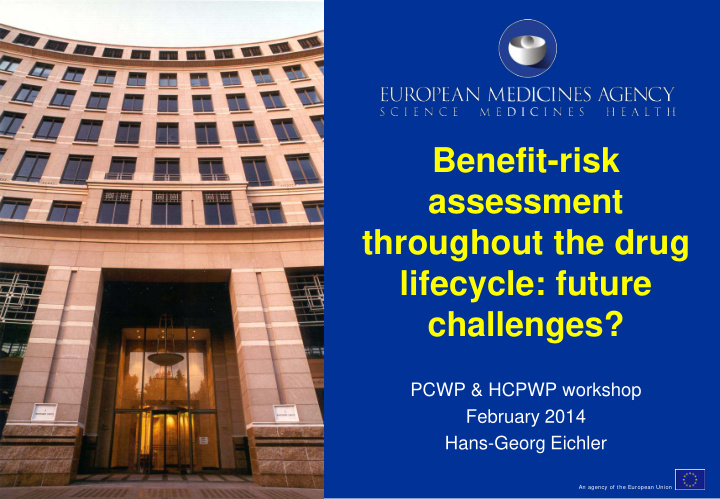



Benefit-risk assessment throughout the drug lifecycle: future challenges? PCWP & HCPWP workshop February 2014 Hans-Georg Eichler An agency of the European Union
Anatomy of benefit-risk assessment • Incoming signals • Information processing • Outgoing (re-)action 2
Agenda • Incoming signals – Noise, signals, data, information • Information processing – Facts, values, uncertainty, risk aversion • Outgoing (re-)action – Communication, modifying human behaviour 3
Agenda • Incoming signals – Noise, signals, data, information • Information processing – Facts, values, uncertainty, risk aversion • Outgoing (re-)action – Communication, modifying human behaviour 4
What comes in? Sources of data: • randomised controlled trials • uncontrolled clinical trials • spontaneous adverse event reports • registries • observational studies (in many forms and shapes) • N-of-1 trials • pragmatic clinical trials • networks, e.g. ‘patientslikeme’ type data • digital social media, apps • anecdotes, media reports 5
Speaking of noise… False positive signals: 2009-12, EMA reviewed 7557 potential drug safety problems; ~1/40 further investigation; 1/157 label changes [Koenig F, Slattery J, et al. Biometrical J 2013, in press] What is signal - what is noise? What information should go into the benefit-risk evaluation? 6
‘Hierarchy’ of evidence and regulatory decision making Ia: systematic review or meta-analysis of RCT’s Ib: at least one RCT IIa: at least one well-designed controlled study without randomisation IIb: at least one well-designed quasi-experimental study, such as a cohort study III: non-experimental descriptive studies, e.g. comparative studies, correlation studies, case–control studies and case series IV: expert committee reports, opinions and/or clinical experience of respected authorities 7
RCT vs. observational data: – Use Bayesian mixed treatment analysis (MTC) quantifying inter-study variability and heterogeneity – Use study level covariate to reflect the design and evaluate e.g. under-reporting of risk outcomes – Perform sensitivity analyses 8
Agenda • Incoming signals – Noise, signals, data, information • Information processing – Facts, values, uncertainty, risk aversion • Outgoing (re-)action – Communication, modifying human behaviour 9
What is expected from a regulator? “[…] Decisions in healthcare are rife with moral disagreements” unanimity is an elusive goal Accountability for reasonableness* : • Transparency • Relevance • Revisability *Daniels N et al. Accountability for reasonableness: an update. BMJ 2008;337:a1850 10
Would a structured decision framework: • add transparency and relevance? • affect the outcome of the decision? The regulators’ decision-rule: • do the benefits outweigh the risks? • is the degree of uncertainty around B & R acceptably low? B - H - U (benefits, harms, uncertainty) 11
Loss (Risk?) aversion Health (QALY, DALY, LYS) 12 Kahneman D. Thinking, Fast and Slow. London, Penguin Books, 2011
The asymmetry of benefit-risk Survey of value judgments among practicing hospital physicians: on average, ‘four or five additional lives had to be saved by better treatment of the disease for each additional death caused by the treatment itself.’ most physicians view death attributable to disease as a more acceptable outcome than death attributable to iatrogenesis. Lenert LA, et al: Primum non nocere? Valuing of the risk of drug toxicity in therapeutic decision making. 13 Clin Pharmacol Ther. 1993; 53(3):285
Would patient involvement or different framing change anything? 14 Eichler et al. The risks of risk aversion. Nature Rev Drug Disc 2013, Dec;12(12):907-16
A structured benefit-risk framework: • will likely add clarity and transparency, perhaps improve the ‘light to heat ratio’ in public debate • may require patient and health care professionals involvement and judicious framing: benefit-risk or risk-risk trade-offs ? • may expose B-R asymmetry influence the decision? 15
Agenda • Incoming signals – Noise, signals, data, information • Information processing – Facts, values, uncertainty, risk aversion • Outgoing (re-)action – Communication, modifying human behaviour 16
Case study: Acomplia (rimonabant 20 mg) Jun 2006: approved for obesity and over-weight patients. (“effect was moderate and of clinical relevance for 20-30% of patients”) 17
Case study: Acomplia (rimonabant 20 mg) Jan 2009: marketing authorisation withdrawn in light of post-approval data (“new data indicated a shorter duration of treatment in real life and a reduced beneficial effect… risk of experiencing the adverse mental effects are higher in patients with comorbidity”) 18
Utilisation, adherence, can/should regulators contribute? • better communication? • better support of technology? • better presentation of (e-) prescribing information at point-of-care? 19
Conclusions Future challenges – we will need to: • fully integrate information based on different types of data and signals • reach out to patients to understand their tolerance for risks and uncertainty • engage with patients and health care providers to seek ways to further optimise utilisation of drugs in the marketplace 20
THANK YOU! Acknow ledgm ents: F.Pignatti, X.Kurz 21 2 1
Recommend
More recommend